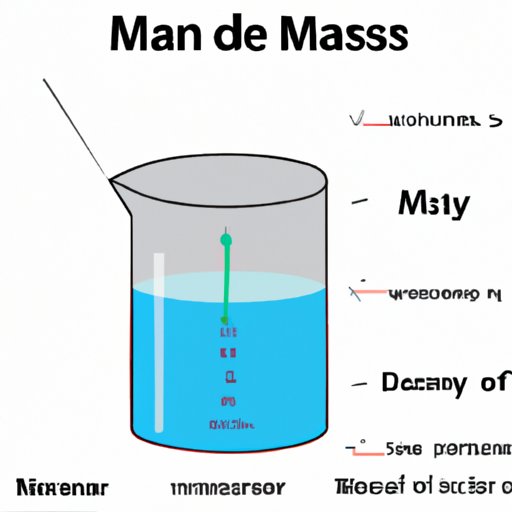
Introduction
Have you ever wondered how scientists and chemists determine the mass of an object or substance? Calculating mass is an essential aspect of science and is crucial in predicting or analyzing events such as chemical reactions. Two essential factors that play a vital role in determining mass are density and volume. In this article, we will take a deep dive into how to find mass using density and volume.
Understanding Density and Volume
Density and volume are individual properties of matter that are used to ascertain mass. Before we explore how to use these two properties to find mass, it is necessary to understand what they mean.
Definition of Density
Density is the measure of mass per unit volume of a substance. More simply, it is a measure of how tight particles are packed together in a given substance. The unit of measurement for density is usually kilograms per cubic meter (kg/m3).
Definition of Volume
Volume, on the other hand, refers to the amount of space that an object or substance occupies. The standard unit of measurement for volume is cubic meters (m3).
Understanding the Relationship Between Density and Volume
Density and volume are closely related in that they can be used to calculate mass. The formula for calculating mass using density and volume is as follows:
Mass = Density x Volume
Therefore, if you know the density of a substance and its volume, you can easily calculate its mass.
Mastering the Art of Density and Volume: A Step-by-Step Guide on Finding Mass
To find mass using density and volume, follow these steps:
Step 1: Identify the Density of the Substance
The first step in finding mass using density and volume is identifying the density of the substance. The density of a substance can be found on reference tables or measured experimentally using a balance or hydrometer.
Step 2: Measure the Volume of the Substance
Next, you need to measure the volume of the substance. The volume of a substance can be measured using different techniques depending on the state of the substance. For instance, if the substance is a solid, you can measure its volume using displacement. If it is a liquid, you can measure it using a graduated cylinder, pipette, or burette.
Step 3: Calculate the Mass of the Substance Using the Formula
With the density and volume of the substance determined, the final step is to calculate the mass using the formula Mass = Volume x Density.

Calculate Mass Like a Pro: Using Density and Volume as Your Guide
Here are a few tips and tricks to help you calculate mass accurately using density and volume.
Tips and Tricks for Accurate Measurements
- Ensure that you use the correct units for density and volume.
- For more accurate measurements, use modern equipment such as digital balances, burettes, or micropipettes.
- Be careful when handling volatile substances such as liquid nitrogen, as they can quickly evaporate and give false volume readings.
- Avoid spilling substances as this could lead to inaccurate measurements.
Common Mistakes to Avoid
- Using the incorrect units for density or volume.
- Measuring volume inaccurately.
- Using the wrong density value for a substance.
Real-World Examples
The easiest way to understand how to use density and volume to calculate mass is by seeing some real-world examples. Below are three examples:
- Example 1: A solid has a density of 2,500 kg/m3 and a volume of 0.002 m3. What is its mass?
- Example 2: A liquid has a volume of 0.3 L and a density of 900 kg/m3. What is its mass?
- Example 3: A gas has a volume of 3,000 m3 and a density of 1.2 kg/m3. What is its mass?
Solution: Mass = Density x Volume = 2,500 kg/m3 x 0.002 m3 = 5 kg. Therefore, the mass of the solid is 5 kilograms.
Solution: First, convert the volume of the liquid from liters to cubic meters by multiplying by 0.001. Therefore, the volume, V = 0.3 L x 0.001 = 0.0003 m3. Then, calculate the mass by multiplying the density and volume: mass = Density x Volume = 900 kg/m3 x 0.0003 m3 = 0.27 kg. Therefore, the mass of the liquid is 0.27 kilograms.
Solution: Mass = Density x Volume = 1.2 kg/m3 x 3,000 m3 = 3,600 kg. Therefore, the mass of the gas is 3,600 kilograms.
The Ultimate Cheat Sheet for Finding Mass Using Density and Volume
Here is a quick reference guide on density and volume:
| Property | Unit of Measurement |
|---|---|
| Density | Kilograms per cubic meter (kg/m3) |
| Volume | Cubic meters (m3) |
Follow these steps to find mass using density and volume:
- Identify the density of the substance.
- Measure the volume of the substance.
- Calculate the mass of the substance using the formula: Mass = Density x Volume.
Common Conversion Factors
Here are some common conversion factors to remember:
- 1 L = 0.001 m3
- 1 mL = 0.000001 m3
- 1 cm3 = 0.000001 m3
- 1 cm3 = 1 mL
From Density to Mass: How to Use Volume as the Missing Link
Volume is an essential factor in determining mass. The equation Mass = Density x Volume can be re-arranged to find other missing quantities. For example, if you know the mass and density of a substance, you can calculate its volume using the equation Volume = Mass/Density.
Examples of How to Use Volume to Calculate Mass
- Example 1: A liquid has a mass of 5 kg and a density of 1,000 kg/m3. What is its volume?
- Example 2: A solid has a mass of 10 kg and a density of 2,000 kg/m3. What is its volume?
Solution: Volume = Mass/Density = 5 kg / 1000 kg/m3 = 0.005 m3.
Solution: Volume = Mass/Density = 10 kg / 2000 kg/m3 = 0.005 m3.
Unveiling the Secrets of Mass Calculation Using Density and Volume
Advanced topics in mass calculation using density and volume include applications in fluid dynamics, and the measurements of density using the Archimedes Principle.
Real-Life Applications of Mass Calculation
Mass calculation using density and volume has several practical applications, including:
- Predicting the behavior of fluids, such as in the design of pipelines and water tanks.
- Figuring out the amount of medication to administer to patients, such as in chemotherapy.
- Calculating fuel efficiency in the automotive industry.
- Determining the amount of chemicals in a solution in the chemical industry.
Solve for Mass with Confidence: The Importance of Density and Volume in Chemistry
Explanation of the Significance of Density and Volume in Chemistry
Density and volume are crucial in chemistry because knowing the mass of substances is essential in accurately predicting the outcome of chemical reactions and formulating drugs. Density is also vital in identifying unknown substances and verifying the purity of known substances.
Importance of Accurately Calculating Mass in Chemical Reactions
Accurate mass calculations are vital in chemistry since many chemical reactions require precise amounts of reactants to produce the desired outcomes.
Finding Mass with Density and Volume Made Easy: Tips and Tricks for the Modern Learner
Recap of Key Concepts
To find mass using density and volume, you need to identify the density of the substance and measure its volume before calculating the mass using the formula Mass = Density x Volume.
Tips for Mastering Mass Calculation
- Understand the meaning and relationship between density, volume, and mass.
- Use modern equipment to ensure accurate measurements.
- Always double-check your calculations and units of measurement.
Common Mistakes to Avoid
- Using incorrect units for density or volume.
- Measuring volume inaccurately.
- Using the wrong density value for substances.
Conclusion
Calculating mass using density and volume is an essential skill in science and chemistry. With this comprehensive guide, you should be able to master the art of finding mass using density and volume. Remember to use accurate measurements, double-check your calculations, and always use the correct units of measurement to get the best results.





